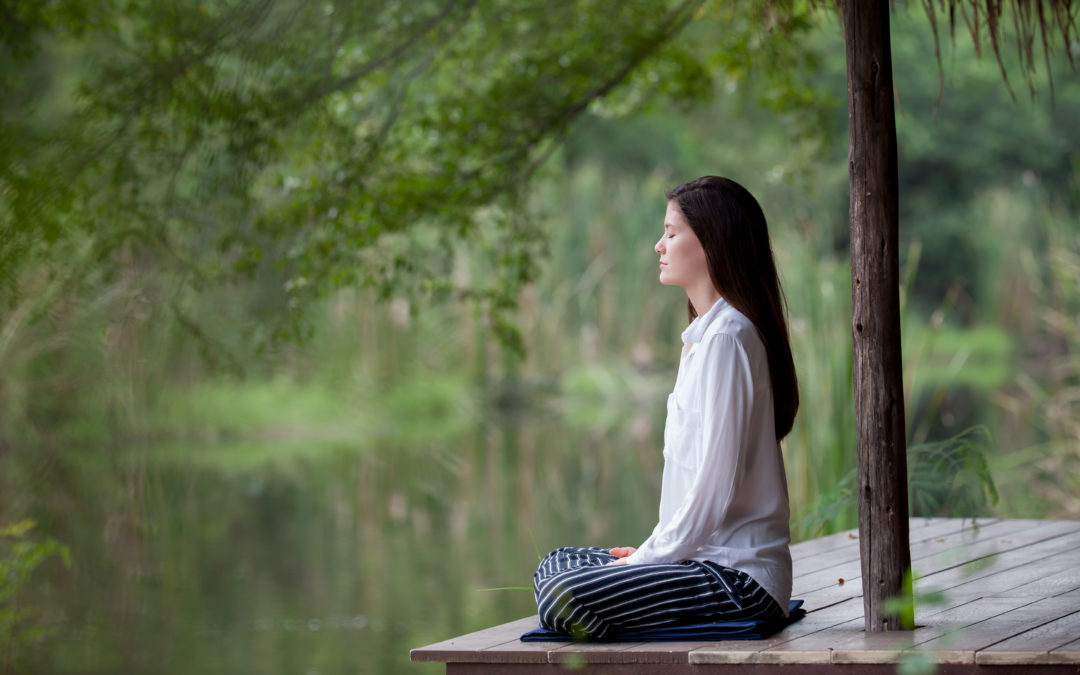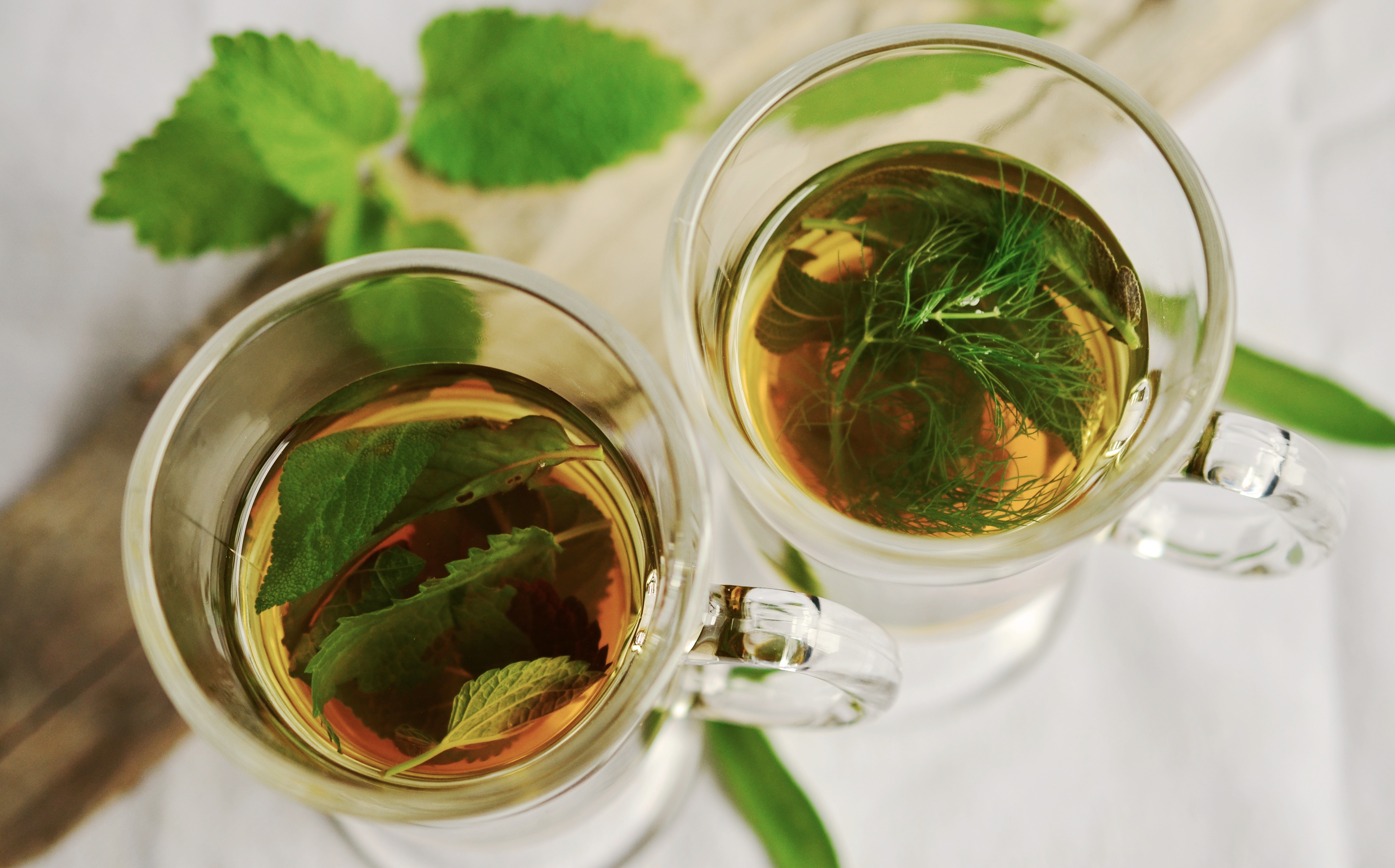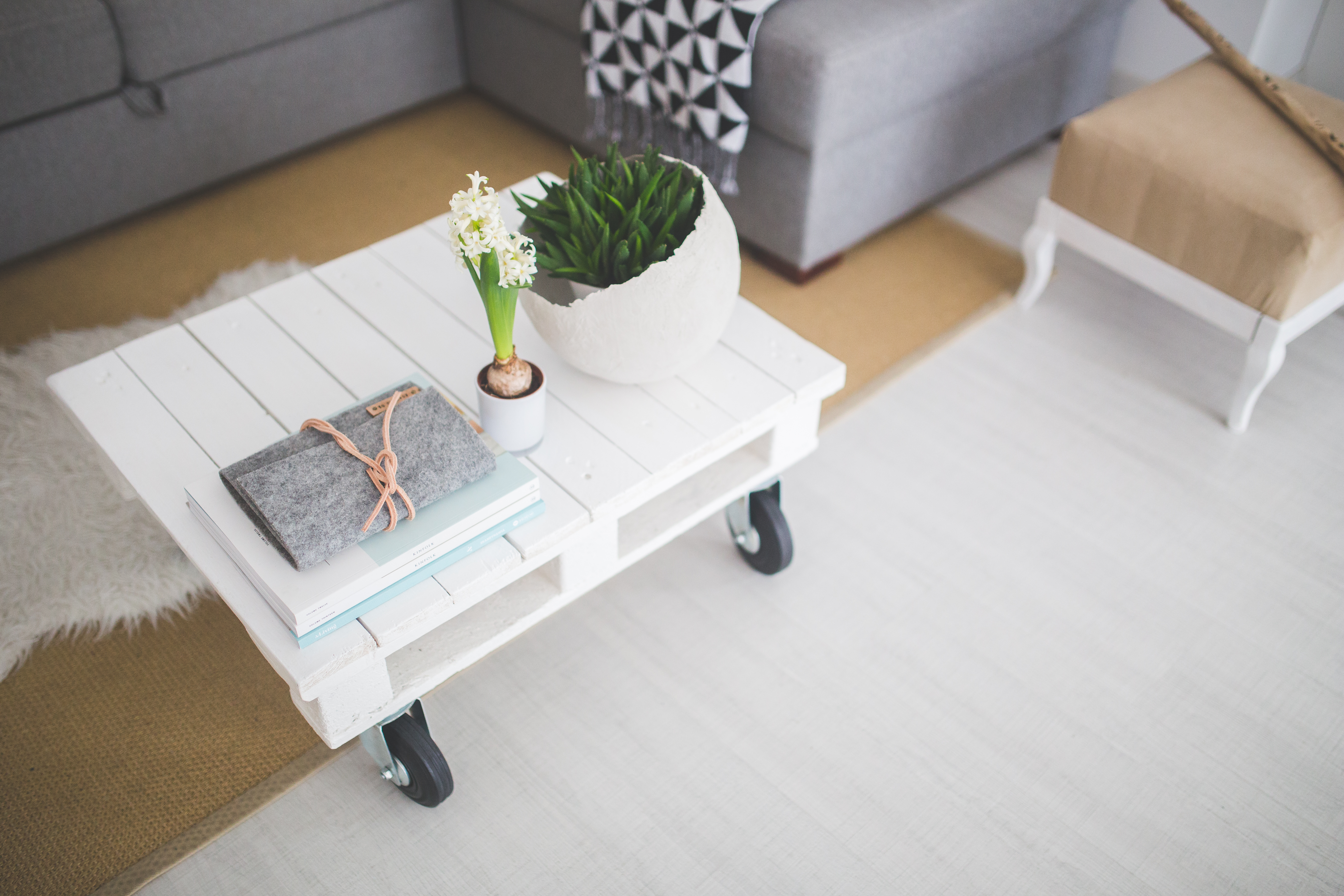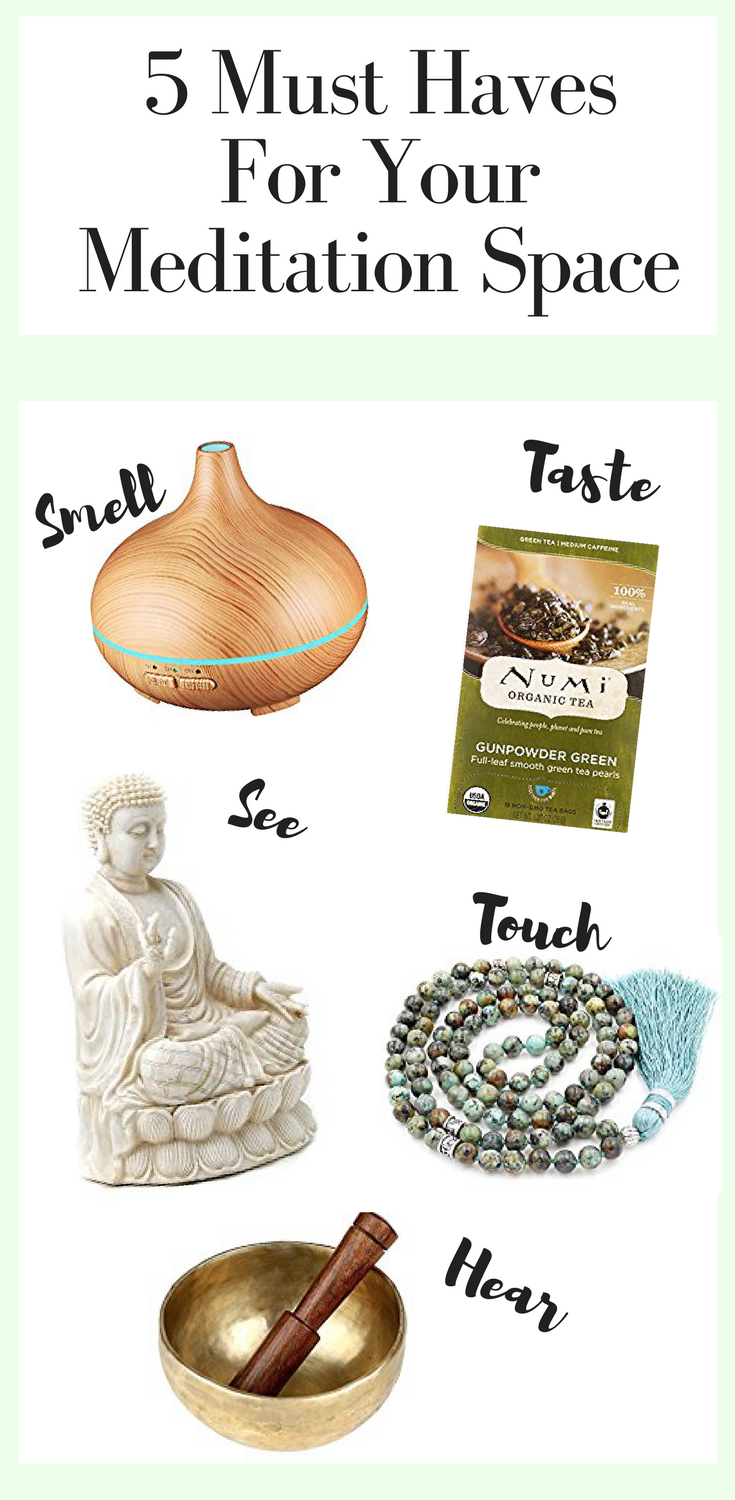
by Caroline | Nov 19, 2018 | Mindful Home, Sustainability
One thing that I’ve been thinking about a lot lately is how much plastic and paper waste a single person produces in a day. There are so many things that we use once and throw away without even thinking twice about it. Unfortunately we’re getting to that point where we really should be more conscious of what our consumption is doing to the planet. Especially during the holidays it’s hard to comprehend just how much plastic and paper is wasted and thrown into the landfill.
Luckily you don’t have to take it to extremes to make a dent in the waste that you are creating this holiday season. There is a powerful Zero Waste Movement happening right now that focuses on making simple swaps for every day items, which means less going into the garbage at the end of the day.
Here are some ideas to get you started being a more conscious consumer. Especially now that the holidays are upon us, a time when there is so much unnecessary waste.
Minimize Single Use Plastic
Simple things like having reusable travel utensils in your car so you don’t have to use plastic forks and knives at Starbucks (I’m totally guilty of that). Same goes for plastic straws, which are wreaking havoc on marine life. By getting some reusable stainless steel straws you can make a simple swap that also helps the environment.
More and more people recently have made it a habit to take their reusable grocery bags to the store, but have you ever though of how much plastic you are wasting with the produce bags you put your greens and other veggies in? Their lifespan is only as long as the veggies you put in them, then they go right in the trash. A smile solution is taking your own produce bags to the grocery store along with your own grocery bags. Same goes for Zip-lock bags, which I use almost every day when I go to work. Instead try using the cute Stasher Reusable Food Bag.
Many businesses and towns are even doing away with plastic bags and straws all together! My hometown got rid of plastic bags in grocery stores and charge people for each brown bag they use. Not only does it cut down on plastic bags which pollute out environment, but the extra charge (which was only like 5 cents or something) was enough incentive to try to remember my reusable bags each time I went shopping.
Another thing is to be aware of what you are purchasing, either as its or just in general. Are you getting gifts for people that come in a ton of plastic packaging or requires bubble wrap because of shipping? Note I’m a huge fan of online shopping for the sanity it saves me, but these are things to be aware of.
Waste Free Gift Wrapping
One of the biggest waste issues around the holidays is all of the gift wrapping and boxes that get thrown out. When I think about it I find it kind of insane that we will use expensive paper for the sole purpose of ripping it up and throwing it out after 5 seconds. I mean, I love how presents look all pretty and wrapped up, but there are more creative, and sustainable ways, to make presents look beautiful.
One way is to use reusable gift wrapping. I found these stretchy fabric bags that can fit around different size boxes and can be used over and over. If you’re not into reusable gift wrapping you can always skip the wrapping paper and reuse gift bags. I know in my family we never have to buy new ones because my mom has a whole closet full of saved gift bags that we just use year after year.
Get creative with brown paper bags. I love using brown paper bags from the grocery store (when I forget my reusable grocery bags of course!) and cutting them up to use as wrapping paper. They are a blank canvas for making fun art that makes each gift unique. Using paint, crayons, stamps, and stickers is a great way to decorate them for any season or holiday, and it’s free! One year my mom used brown paper to wrap all our presents and used Christmas-ey stamps and twine to make them look beautiful! It was an art project in itself, and made wrapping more enjoyable.
Action Step: Here’s something I want you to try…
Tomorrow from the moment you wake up until you go to sleep, notice how much you throw away, or how much unnecessary paper and plastic are a part of your everyday life. Paper towels, ziplock bags, the plastic wrap on food containers, junk mail, makeup remover pads, produce bags, receipts, all of it. Just by becoming aware of how much unnecessary waste you accumulate in one day can be a big motivator in making tiny changes.
And if you’re really interested in learning about more ways you can live a zero waste life (or close to it) is to check out the book, aptly named Zero Waste Home.
I am an affiliate of Amazon, which means that if you make a purchase from any of these links I may make a small commission, as no extra cost to you. This helps me maintain and run this website and keep putting out good content for you all to enjoy. Thank you for supporting Bloom & Spark!
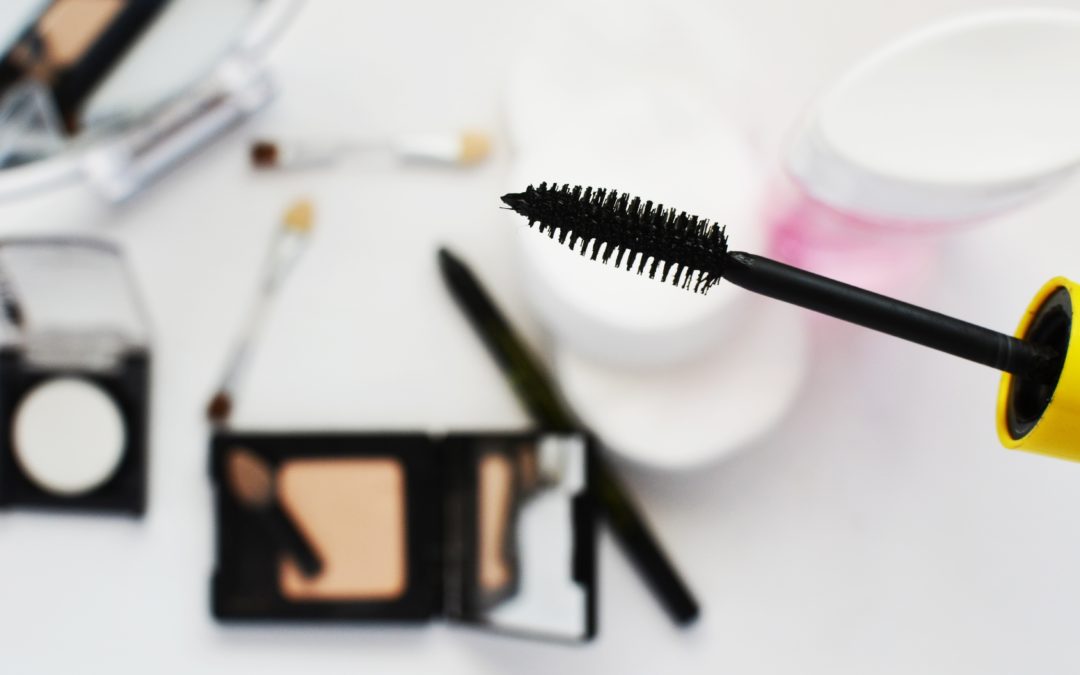
by Caroline | Aug 22, 2018 | Mindful Home, Sustainability
As I said in part 1 of this skincare series, I’ve been really interested in cleaning up my personal products, taking out any harmful skincare ingredients, and replacing them with ones that are safer for me and the environment. When starting to research products and ingredients I came upon a startling fact…
While the European Union has banned 1,328 harmful chemicals and ingredients, the United States has only banned 30.
omg say WHAT?!?!?!?!
That means there are thousands of chemicals Americans use and eat every day, that in other parts of the world are not deemed safe for humans. We’re talking pesticides, food additives, dyes, preservatives, chemicals in personal products like cosmetics, toothpaste, deodorant, and shampoo. That’s freakin’ messed up and I’m really not cool with it!
Are you as baffled as I am? This is one of the most shocking and upsetting statistics I have heard in years. It makes me think “WTF is wrong with us? Why are are so backwards on this?”
Here’s why. In short, most countries take the stance that if there is credible evidence of danger to human or environmental health, preventative action is taken by banning the product, whether or not the science has yet to prove it’s unsafe.
The US, on the other hand sees it as an “innocent until proven guilty” type of deal. Meaning if there is concern over a product, it will not be banned until certain and conclusive studies have been conducted, proving a high level of harm.
You can see my article in part 1 of this series, when I took a startling look at the ingredients in some of my daily skincare products. I highly encourage you to check out the Environmental Working Group’s website to look at the safety of ingredients in your products.
But for now this is what I want you to be aware of. Please, ladies look at your labels!
HARMFUL INGREDIENTS YOU SHOULD AVOID
Benzalkonium Chloride
A disinfectant used as a preservative and surfactant associated with severe skin, eye, and respiratory irritation and allergies. Found in: sunscreens, moisturizers.
Butylatedhydroxy Anisole and Butylated Hydroxytoluene
Synthetic antioxidants used to extend shelf life. They are likely carcinogens and hormone disruptors and may cause liver damage. Found in: lipsticks, moisturizers, diaper creams, and other cosmetics.
Coal tar hair dyes and other coal tar ingredients
A byproduct of coal processing that is a known carcinogen. It is used as a colorant and an anti-dandruff agent. Found in: hair dye, shampoo.
Ethylenediaminetetraacetic acid (EDTA)
A chelating (binding) agent added to cosmetics to improve stability. May be toxic to organs. Found in: hair color, moisturizers.
Ethanolamines (MEA/DEA/TEA)
Surfactants and pH adjuster linked to allergies, skin toxicity, hormone disruption, and inhibited fetal brain development. Found in: hair dyes, mascara, foundation, fragrances, sunscreens, dry cleaning solvents, paint, pharmaceuticals.
Formaldehyde
Used as a preservative in cosmetics. A known carcinogen that is also linked to asthma, neurotoxicity, and developmental toxicity. Present where quaternium-15, DMDM hydantoin, imidazolidinyl urea, diazolidinyl urea, sodium hydroxymethylglycinate, 2-bromo-2-nitropropane-1,3 diol (Bronopol), and several other preservatives are listed. Found in: shampoo, body wash, bubble bath.
Hydroquinone
A skin-lightening chemical that inhibits the production of melanin and is linked to cancer, organ toxicity, and skin irritation. Found in: skin-lightening creams.
Methylisothiazolinone and methylchloroisothiazolinone
Chemical preservatives that are among the most common irritants, sensitizers, and causes of contact skin allergies. Found in: shampoo, conditioner, body wash.
Oxybenzone
Sunscreen agent and ultraviolet light absorber linked to irritation, sensitization and allergies, and possible hormone disruption. Found in: sunscreen, moisturizer.
Parabens (methyl-, isobutyl-, propyl- and others)
A class of preservatives commonly used to prevent the growth of bacteria and mold. Parabens are endocrine (or hormone) disruptors, which may alter important hormone mechanisms in our bodies. Found in: shampoo, face cleanser, body wash, body lotion, foundation.
Phthalates (DBP, DEHP, DEP and others)
A class of plasticizing chemicals used to make products more pliable or to make fragrances stick to skin. Phthalates disrupt the endocrine system and may cause birth defects. Found in: synthetic fragrance, nail polish, hairspray, and plastic materials.
Polyethylene glycol (PEG compounds)
PEGs are widely used in cosmetics as thickeners, solvents, softeners, and moisture-carriers. Depending on manufacturing processes, PEGs may be contaminated with measurable amounts of ethylene oxide and 1,4-dioxane, which are both carcinogens. Found in: creams, sunscreen, shampoo.
Retinyl palmitate and Retinol (Vitamin A)
A nutrient that may damage DNA and speed the growth of skin tumors when used topically. Found in: moisturizer, anti-aging skincare.
Sodium Lauryl Sulfate and Sodium Laureth Sulfate (SLS and SLES)
SLS and SLES are surfactants that can cause skin irritation or trigger allergies. SLES is often contaminated with 1,4-dioxane, a byproduct of a petrochemical process called ethoxylation, which is used to process other chemicals in order to make them less harsh. Found in: shampoo, body wash, bubble bath.
Synthetic flavor or fragrance
An engineered scent or flavoring agent that may contain any combination of 3,000-plus stock chemical ingredients, including hormone disruptors and allergens. Fragrance formulas are protected under federal law’s classification of trade secrets and therefore can remain undisclosed. Found in: all types of cosmetics.
Toluene
A volatile petrochemical solvent that is toxic to the immune system and can cause birth defects. Found in: nail polish.
Triclosan and Triclocarban
Antimicrobial pesticides toxic to the aquatic environment; may also impact human reproductive systems. Found in: liquid soap, soap bars, toothpaste.
*this list is actually known as The Never List, put out by Beauty Counter. I found it the most comprehensive, yet simple to understand list out there*
If you find this disturbing, the best things you can do are to look at the ingredients in the products you use every day, share this with a girlfriend (’cause we look out for each other), and start looking for products with safer ingredients. I’ll show you how to do that in part 3 of this blog series!
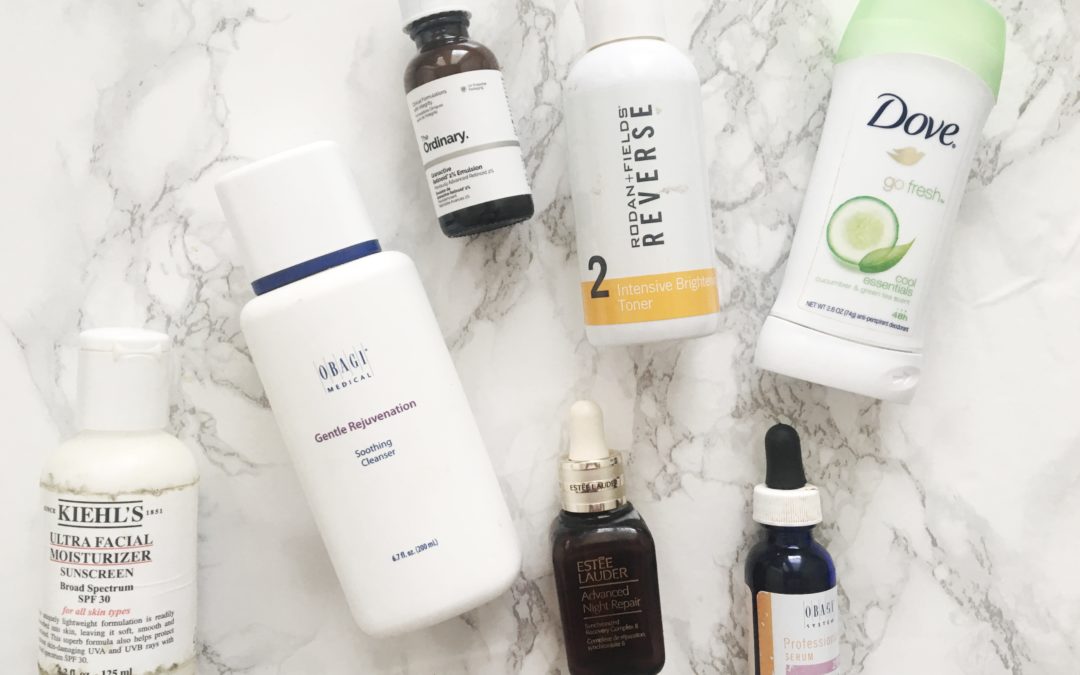
by Caroline | Aug 20, 2018 | Mindful Home, Sustainability
So for a long time I have kept telling myself that the next time I need a new cleanser, moisturizer, shampoo, etc. I’m going to really do my research and find products with safer skincare ingredients for both my body, and the environment. I’ve heard about how lots of skincare ingredients in our everyday products are pretty harmful, and considering how many products we all use, it was important to me that I start cleaning it up.
Well, ingredients lists are confusing to say the least. I don’t recognize, nor can I pronounce, any of the terms, and I didn’t know where I could turn to get some answers. I finally came upon the Environmental Working Group website, which has been a really helpful resource, and I encourage all of you to go check it out.
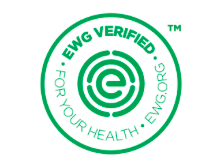 It allows you to research not only ingredients, but you can also search for the products youse to find if they are deemed safe. They also have a special mark they put on products that are verified by the EWG which recognizes products that meet EWG’s strictest standards for your health. SO you know which products don’t contain chemicals of concern. I found this especially helpful, and now am striving to only buy products that are EWG verified. Here’s what the mark looks like:
It allows you to research not only ingredients, but you can also search for the products youse to find if they are deemed safe. They also have a special mark they put on products that are verified by the EWG which recognizes products that meet EWG’s strictest standards for your health. SO you know which products don’t contain chemicals of concern. I found this especially helpful, and now am striving to only buy products that are EWG verified. Here’s what the mark looks like:
I like to keep my standards high, and this seems like it will help me, without hours of frustrating google searches.
So with this new information right at my fingertips, I decided to check on three of the products I use on a daily basis (I use more than 3, but to avoid an extremely long post, I kept it to 3 so you could see how it works).

Product #1: Dove go fresh deodorant (cool essentials scent)
This one came back with 12 ingredients of concern (yikes!). The highest concerns include contamination concerns, irritation, persistence, and bioaccumulation.
Score: 4/10 (moderate hazard) *just for reference the higher the number, the higher the hazard*
Top 4 Suspect Ingredients
- Fragrance– skin irritation, organ system toxicity, ecotoxicology
- BHT– Cancer (WTFFFFFF), organ system toxicity, endocrine disruption, developmental/reproductive toxicity.
- Cyclopentasiloxane– organ system toxicity, neurotoxicity, cancer, endocrine disruption, ecotoxicology.
- Steareth-100- organ system toxicity, ecotoxicology.
Product #2: Obaji Medical Gentle Rejuvenation Soothing Cleanser
This one came back with 4 ingredients of high concern, and 7 ingredients of moderate concern. The highest concerns are Endocrine disruption, Multiple, additive exposure sources, Contamination concerns, Irritation (skin, eyes, or lungs), Miscellaneous, Occupational hazards, Persistence and bioaccumulation
Score- 6/10 (on the high end of “moderate” hazard”)
Top 4 Suspect Ingredients:
- Fragrance-allergies/immunotoxicity, irritation, organ system toxicity, ecotoxicology.
- Isobutylparaben– use restrictions, allergies/immunotoxicity, endocrine disruption, developmental/reproductive toxicity, biochemical or cellular level changes.
- Bropylbaraben– use restrictions, allergies/immunotoxicity, endocrine disruption, developmental/reproductive toxicity, ecotoxicology
- Butylparaben– use restrictions, allergies/immunotoxicity, endocrine disruption, developmental/reproductive toxicity, ecotoxicology
Product #3: Kiehl’s Ultra Facial Moisturizer Sunscreen SPF 30
This one actually game back pretty good with a low overall concern (7 ingredients of moderate hazard,and 10 ingredients of low hazard)
Score: 2/10 (low hazard) woop woop!
Top 5 Suspect ingredients:
- Thiethanolamine-use restrictions, allergies/immunotoxicity, organ system toxicity (non-reproductive), contamination concerns
- Homosalate-use restrictions, organ system toxicity (non-reproductive), endocrine disruption, ecotoxicology, contamination concerns
- Octisalate– use restrictions, allergies/immunotoxicity, ecotoxicology
- Phenoxythanol– Irritation, use restrictions, organ system toxicity, allergies/immunotoxicity
So, luckily nothing came back in the severe hazard range, the the Obagi facial cleanser was just one point away from it, which is upsetting because I got it from my aesthetician at a medical spa and paid a pretty penny for it. I expected it to be the best one, alas, it wasn’t. Either way it’s a eye opening experience to see the chemicals that I am putting on my body every day.
In the next post in this series I’ll share about the ingredients you DEFINITELY don’t want in your products and how to start finding safer products.
Until next time!

</>
by Caroline | Jul 9, 2017 | Mindful Home, Sustainability
As a kid my family would take a vacation every summer to Block Island, a small pristine island off the coast of Rhode Island. I still go there every summer, and next summer my fiancé and I will be married there! It is one of the most special places on earth; I call it my happy place. There’s just something magical about it that I can’t put into words, but if you have ever been there you know what I mean.
So when I came across Block Island Organics I couldn’t contain my excitement!! Er-meh-gerd!!! I know a lot of my friends and readers are conscious about what they put in their bodies and on their skin, and I’m always looking for a great organic skincare line that is safe and not in the three figures.
I’ve had the opportunity to test out their Revitalizing Night Cream for a few months now, and since it’s summer, (and I will be vacationing on Block Island next month) I can’t wait to try out their Mineral Sunscreen.

So heres what ya need to know:
- Block Island Organics is a family business, created by brother and sister Will and Lauren von Bernuth, along with Will’s wife Kelly.
- They are all about helping educate people on healthy sun protection and safe skincare.
- They use NO parabens, sulfates, phthalates, dyes, artificial fragrances or gluten.
- Products are vegan, cruelty free, and never tested on animals.
- They use organic ingredients such as rosehip, chamomile, sunflower, avocado, and olive.
Ingredients
I believe that ingredients matter a lot when it comes to skincare and so does Block Island Organics. I love that they give full disclosure of the ingredients and their reasons for choosing them. Right on their website they have a list of every single ingredient in the products and what it is used for. For all my educated consumers out there like me who stand in the grocery store googling every ingredient before purchasing something- they’ve got you covered!

I love that there are no fragrances too, because they can sometimes irritate my sensitive skin. I find that the night cream is super moisturizing without feeling heavy and thick. Plus every time I use it I think of my favorite vacation spot!
I share this product as someone who genuinely likes and uses it. I was not paid to write this review. Hopefully you will get a chance to try out these cruelty free and vegan products if that’s your thing. Happy summer!
XO

PS.. Because I freaking love all of you so much I wanted to share my discount code if you want to snag yourself some of these kickass products. Use the code “caroline” at checkout to get 20% OFF!

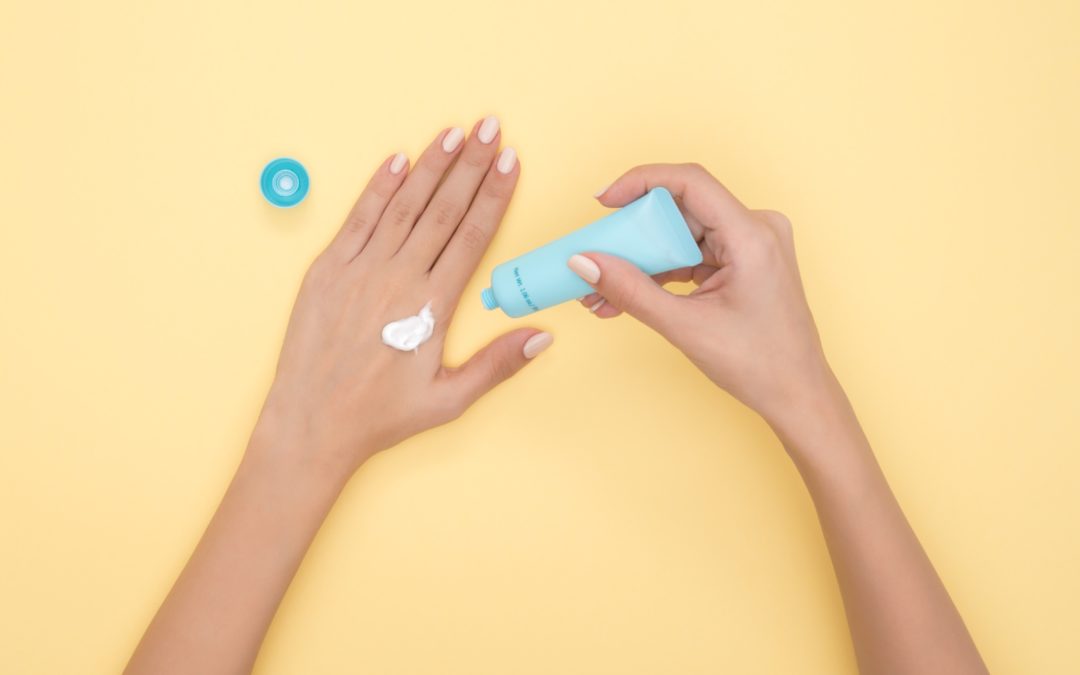

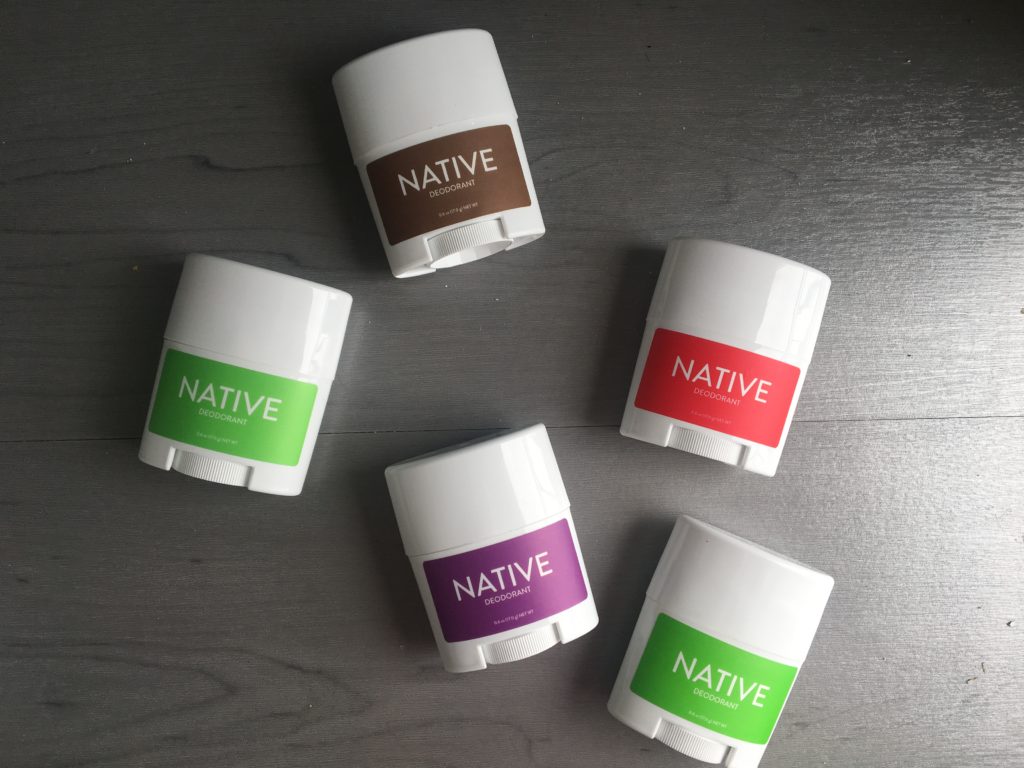
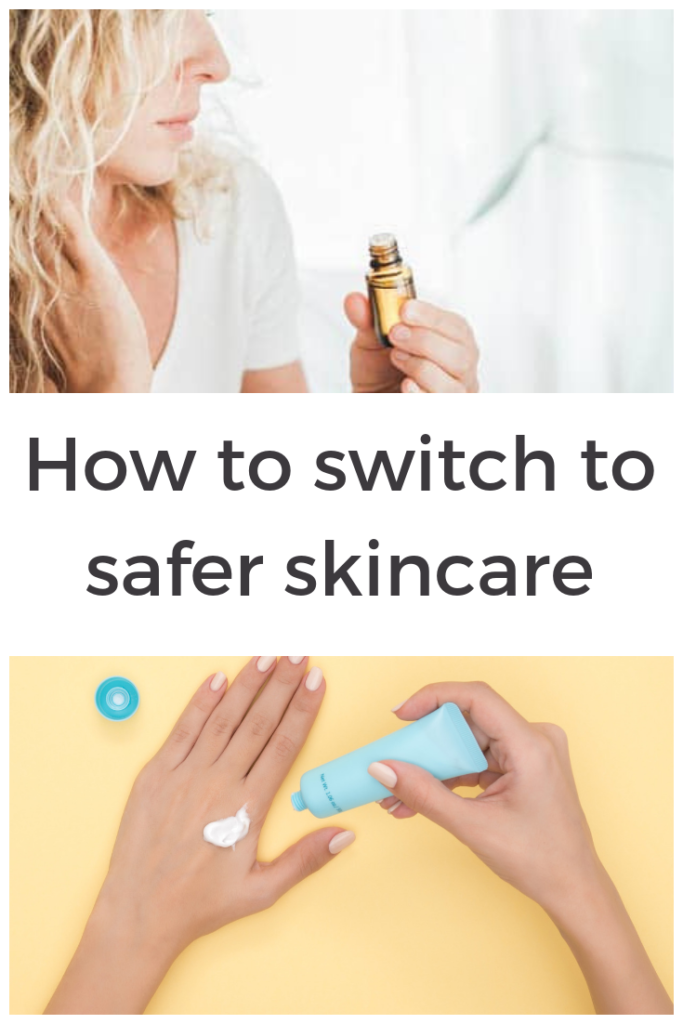





 </>
</>
